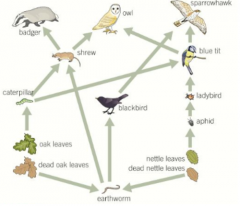![]()
![]()
![]()
Use LEFT and RIGHT arrow keys to navigate between flashcards;
Use UP and DOWN arrow keys to flip the card;
H to show hint;
A reads text to speech;
12 Cards in this Set
- Front
- Back
|
Ecosystems |
Ecology is the name of the study of the relationship between organisms and their environment Helps to understand the interdependence of living organisms and to help ensure the survival of as much biodiversity as possible An ecosystem is made up of all living organisms that interact with one another in a defined area, and also the physical factors present in that region Ecosystems can vary drastically in size - from a tiny bacterial colony to the entire biosphere of Earth Components include habitats, populations and communities Ecosystems vary widely - a single colony of bacteria to whole planet The Earth is defined as the Biosphere - sum total of all ecosystems |
|
|
Factors affecting ecosystems |
Ecosystems dynamic - constantly changing as a result of the living organisms present and the environmental conditions Biotic factors - the living factors, how other organisms and their interactions, affect the population of another species. For example, the organisms present, the size of the populations, the competition of populations Abiotic factors - the nonliving or physical factors and how they affect the population sizes. Include the amount of rainfall and yearly temperature range |
|
|
Biotic factors |
Interactions of organisms that are living or have lived Often involve competition - food, territory, breeding partners Predation, symbiosis, disease agents |
|
|
Abiotic factors |
Air, water, light, wind, soil, pH, temperature, salinity, humidity, inorganic nutrients |
|
|
Light |
Most plants directly affected by light availability for photosynthesis The greater the availability of light, the greater the success of a plant species Plants develop strategies to cope with different light intensities such as larger leaves or photosynthetic pigments that require less light, or productive systems that only operate only when light availability is at an optimum |
|
|
Temperature |
Temperature affects enzymes controlling metabolic reactions Plants and ectotherm animals develop more rapidly in warmer temperatures Changing temperatures can cause seasonal migrations, leaf-fall, dormancy or flowering |
|
|
Water availability |
In most plant and animal populations, a lack of water leads to stress and death if severe Cause most plants to wilt as needs to keep cells turgid to hold upright and for photosynthesis Xerophytes develop strategies to cope with water stress |
|
|
Oxygen availability |
In aquatic ecosystems, it is beneficial to have fast-flowing cold water as high concentrations of oxygen If too warm or slow then oxygen concentration drops and can lead to the suffocation of aquatic organisms In waterlogged soils, the air spaces in soil are filled with water and reduces the oxygen available for plants |
|
|
Edaphic soil factors |
Different soil types have different particle sizes and has an effect on the organisms that are able to survive in them 3 main soil types - Clay - fine particles, easily waterlogged, forms clumps when wet Loam - different-size particles, retains water but not waterlogged Sand - coarse, well-separated particles that allow free draining, doesn’t retain water and easily eroded |
|
|
Dynamic ecosystems |
Dynamic as constantly changing Cylindrical - changes repeat themselves in a rhythm Directional - change doesn’t return to a previous point and lasts a long time Unpredictable - nothing can be determined and no rhythm or direction |
|
|
Food webs |
All organisms found require a source of energy to perform the functions needed to survive The sun is the source of energy for almost all ecosystems The sun's energy is converted into chemical energy in plants by photosynthesisThis chemical energy is then transferred to other non-photosynthetic organisms as food Food chains almost all start with plants which are producers Other organisms are consumers - primary, secondary, tertiary Decomposers feed on the waste and dead matter at each trophic level |
|
|
Food web picture |

|

